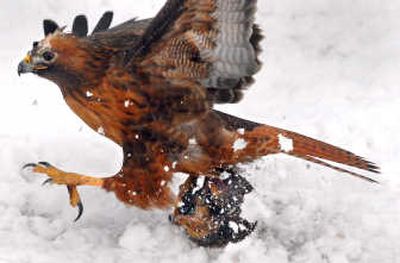Hawks navigate shrinking Prairie

“Hawk ahead,” Roland Craft said suddenly, pulling over onto the shoulder of Lancaster Road.
The three people in the Subaru whipped out their binoculars, training them on the bird perched on a power pole overlooking the Rathdrum Prairie.
Details emerged: A short, curved beak, designed to shred flesh. Watchful tawny eyes. Dark feathers.
“I’m going to call it a rough legged hawk,” Janet Callen said as the hawk broke into flight, flashing a light underbody with dark squares on the wings.
Rough legged hawks – named for their feathered legs – are arctic birds that winter in the Inland Northwest. Craft and Callen, Coeur d’Alene Audubon members, counted six on a recent trip, along with four red-tailed hawks.
Future generations might not be so lucky.
The prairie is prime habitat for both species, which hunt rodents in the large, open spaces. It’s also one of the fastest disappearing land types in Kootenai County, with hundreds of acres lost to new development each year.
“When we used to look out over the prairie at night, it was all dark,” said Kris Buchler, another North Idaho birder. “Now it’s covered with lights.”
Real estate signs dotted the fields where Craft and Callen spied hawks. They counted three hawks in one field with aging farm buildings and a “Tomlinson Black – Future Development Site” sign. A residential neighborhood already occupied the other side of the road.
Like hawks, developers are attracted to the prairie’s open space. Over the past decade, cities around the Rathdrum Prairie have annexed thousands of acres for development. The remaining open space – estimated at 10,000 acres in a 2003 study – is also coveted ground.
“The Rathdrum Prairie and northern Kootenai County are the two areas best suited to accommodate population increase,” according to a draft of the county’s new comprehensive plan, designed to guide land-use decisions over the next 20 years.
The draft proposes clustered, village-style developments of up to 4,000 residents each on the prairie. Scott Clark, the county’s building and planning director, said the goal is to allow housing in urban densities, while still preserving open tracts of land.
“As time marches on, the prairie will be more and more developed,” said Colin Coles, senior planner for the city of Post Falls, whose population has more than tripled over the past 15 years.
Written records of rough legged hawks in Kootenai County date back to the 1890s, when Major J.C. Merrill – an Army surgeon at Fort Sherman in Coeur d’Alene – included them in his birding diary.
The hawks show up in early October and stay for six months. Red-tail hawks are spotted here year-round, but the birds seen in the winter are also migrants that come down from northern Canada.
Though both hawk species are common in North America, asphalt is one of their downfalls. They can co-exist with humans in urban environments only if they have large, grassy areas to hunt. Perches are also important.
“They’re a sit-and-watch predator,” said Stephen Lindsay, a retired veterinarian who writes a monthly birding column for The Spokesman-Review. “They’re watching for prey activity on the ground. Then they swoop down and pounce.”
The Rathdrum Prairie may look barren to the casual observer, but in terms of biomass, it actually supports more animal life than a similar-sized patch of northern coniferous forest, Lindsay said.
“The prairie is alive on the ground – with ground squirrels, gophers and several kinds of mice. … But everything is below the grass. It’s all taking place on the level where most people aren’t aware of it,” he said.
As productive as the area is for wildlife, the Rathdrum Prairie is altered land, Lindsay noted. Even calling it “prairie” is a misnomer, he said. Most of the native habitat disappeared two or three generations ago, when wild grasses were plowed under for crops.
Lindsay believes that’s why environmental groups haven’t rallied to save the Rathdrum Prairie from development.
“It’s not a natural area,” he said. “There isn’t any real prairie left.”
Barry Rosenberg, executive director of the Kootenai Environmental Alliance, said the county’s earlier efforts to preserve large tracts of the prairie failed for lack of funding. The remaining open space is broken into fragments.
The Coeur d’Alene Audubon chapter has kept annual records of hawk numbers on the Rathdrum Prairie since 1991. The counts vary from year to year, depending on weather and food sources. That makes it hard to track how habitat loss is affecting local hawk populations, said Shirley Sturts, the chapter’s newsletter editor.
During a bountiful rodent year, two hawks might find enough food to survive on five-acres, Lindsay said. But mice populations run in cycles. To sustain the raptors’ presence over longer periods, they need large areas to hunt.
As the Rathdrum Prairie fills in, Lindsay predicted that the hawks will head south to better pickings on the Palouse.
In relative terms, the prairie is a small pocket of habitat. “If the hawks were to lose all of the Rathdrum Prairie, it’s not a big deal” on a global level, Lindsay said.
The greater loss might be to local residents, who would have fewer opportunities to admire the symmetry of a soaring hawk.
“It is a big deal to people who like to watch them,” Lindsay said.